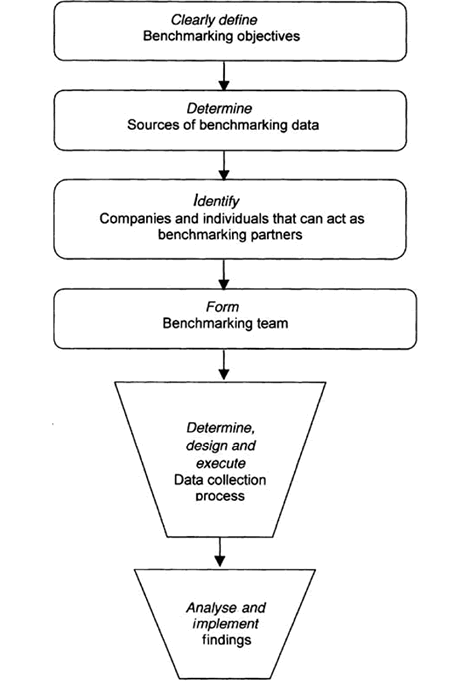FOOD
PRODUCT DEVELOPMENT
Mary Earle, Richard Earle and Allan Anderson |
| Loading
|
product development |
|
||||
|
|
|
Part
3, Chapter 8
Improving the product development process 8.2.2 Basic steps for benchmarking product development There are some basic steps in benchmarking, shown in Fig.
8.2, which need to be followed to maximise the return on any investment in benchmarking (Zairi, 1998; Czarnecki, 1999; Barclay
et al., 2001).
 Fig. 8.2 Basic steps in benchmarking. Clearly define the benchmarking objectives Before beginning a benchmarking study, the organisation should be clear on what the subject is to be; what are the desired outcomes; who will use the results; and how will the results be used to benefit the organisation in the future. It is all too easy to embark on wide-ranging data collection, which, in the end, provides very little useful information for the organisation and its specific requirements. Determine the sources of benchmarking data The benchmarking can be internal and using internal data sources, but usually the comparison is with companies within the specific industry or in industry in general. Sources include the following:  Published materials. Case studies, industry surveys and research Published materials. Case studies, industry surveys and research into R&D management methodology and practices provide an excellent source of primary data. These materials can also be used to prepare a list of potential benchmarking partners.  Databases. For example those prepared by the Industrial Research Databases. For example those prepared by the Industrial Research Institute (IRI) in the USA, provide an excellent source of information on level of spending on R&D, number of R&D employees, number of patents granted, etc. Regular summaries of these data are presented in the Journal of Research – Technology Management. Identify companies and individuals that can act as benchmarking partners This partnership can range from an infrequent exchange of general information about company operations and practices to regular meetings where details relating to company practices are shared with a common aim of improving the overall practices of both partners. It is important not to be limited to similar companies in the selection of partners. Look to the best practices, wherever they occur. The object is to learn from the leaders, those with world-class operations and techniques. Form a benchmarking team Although an individual can conduct a benchmarking study, a team effort will usually get a better return. Involving a cross-section of people with different skills and organisational responsibilities will provide benefits not only in the capture of the information but it will also enable greater acceptance and more rapid assimilation of best practices into the organisation. Determine, design and execute the data collection process There are various ways of collecting benchmarking information, including telephone interviews, postal surveys, face-to-face meetings and desk-top research. Clearly, the type of information required, the level of detail and the available budget will determine the methodology. The best approach is probably to start with the relatively simple desk research to provide the background material and further clarify the critical information required from surveying or from face-to-face meetings. Analyse and implement the findings Very often there will be a number of valuable findings from the study. It is important to prioritise these and to focus on the implementation of a manageable few. Commitment and support from senior management is an important starting point. It is also essential that besides showing that these are 'best practice initiatives' there must also be clear evidence to all who are involved in the implementation that there is real benefit to their business. It is important in setting up a benchmarking or assessment system that it should be (Barclay et al., 2001):  relevant to the users' needs; relevant to the users' needs;
 fairly comprehensive; fairly comprehensive;
 capable of a variety of approaches; capable of a variety of approaches;
 both educational and action-oriented; both educational and action-oriented;
 capable of being used in total or selectively; capable of being used in total or selectively;
 able to 'force' the development and implementation of action plans. able to 'force' the development and implementation of action plans.
In other words, set up a system that does not overwhelm with information, but gives the knowledge needed to lead to product development improvement. In Box 8.1 is shown the development of benchmarking in the New Zealand Dairy Board, which shows some methods that can be used in benchmarking the total product development in a company.
This benchmarking development shows in sequence the aims of firstly product development efficiency (doing things right) and then product development effectiveness (doing the right things); and also the use of different evaluation methods and different consultants. The important part in benchmarking is to choose the correct measures or metrics.
|
|
 |